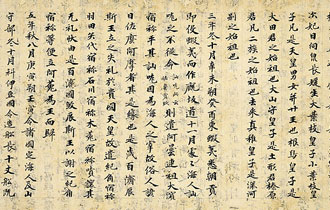daimyō
A generic term applied to the largest of the landholding military lords in premodern Japan. Daimyō built castle towns in their domains from which they could control their vassals and the villages that served as their land base. It was upon this condition of extreme territorial decentralization that military unification was imposed, first by Oda Nobunaga and then by Toyotomi Hideyoshi in the late 16th century. During the Tokugawa Period (1600-1868), the shogunal authorities created a system of control called the bakuhan system. Under this system, a strong national authority (the shogunate or bakufu) reigned above the daimyō. However, the shogun granted the various daimyō certain rights of autonomy within their own domains: rights of taxation, law enforcement, criminal justice, and the maintenance of a domain army. In return, daimyō recognized certain responsibilities: absolute loyalty to the shogun, adherence to the shogun's basic laws, the provision of military services on demand, the fulfillment of periodic demands by the shogun for assistance in the construction of castles and other public words, the peaceful administration of the domain, and the requirement to reside every other year at the shogun's court in Edo (now Tokyo). This bakuhan system was one of the characteristic features of the Tokugawa government. Following the Meiji Restoration in 1868, the daimyō and their domains were abolished and the bakuhan system was dismantled. A system of 75 prefectures replaced the domains, and the former daimyō became a pensioned nobility residing in Tokyo. (from Japan: An Illustrated Encyclopedia. Tokyo: Kodansha, 1993)
There is currently no content classified with this term.











